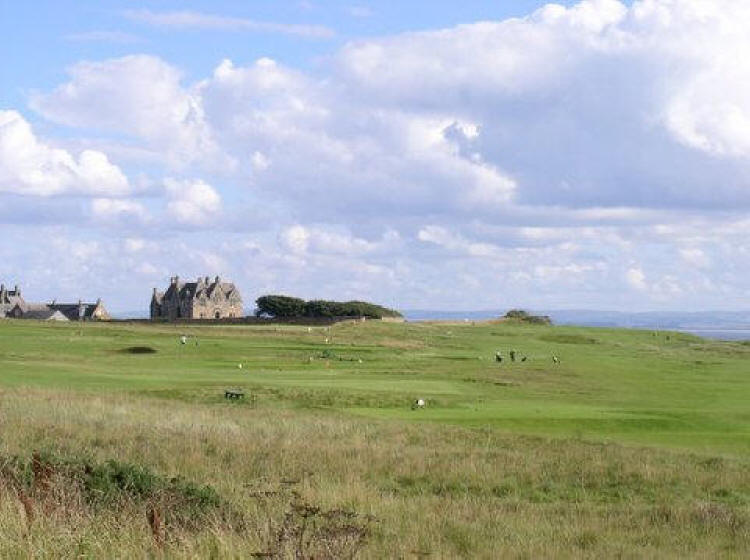Unlike the other coastal
villages of the
East Neuk of Fife, by the 19th
Century, making a livelihood by fishing the waters of the
North Sea and the Firth of Forth had long ceased to exist at
Earlsferry. History books tell
of a disastrous storm at sea that sank the entire fleet of
Earlsferry fishing boats and all
of the fishermen drowned. No doubt this event would cause
the next generation of Earlsferry
men to look to natural resources other than the sea in order
to make a living.
To quote from the historical
book, "The Kingdom", that's edited by
Kilrounie, "The industry
suffered a severe blow - that during a fearful storm all the
boats of Earlsferry were lost
and the whole fishing population perished. There's record
of a storm that occurred on
August 17th, 1579 when
60 fishing boats foundered near Dunbar. In November of
1863 another fearful storm sank 36 East of Fife
fishing boats and all of the men aboard were drowned."
In this same book Kilrounie also tells of the Eyemouth
Disaster that occurred on Black Friday, October 14th 1881
when another storm took the lives of 189 fishermen.
To quote from the Reverend W.
Wood's book, "The East Neuk of Fife," "
In 1776 seven fishermen of Earlsferry were drowned
in one
boat and since that time it has ceased to be a fishing
place." For one fishing boat to have seven
men on it and all of their fishing gear the fishing boats of
that time must have been large vessels. Such craft would
require a very good harbour which now does not exist at
Earlsferry. In these days boats had only sails for
propulsion.
|
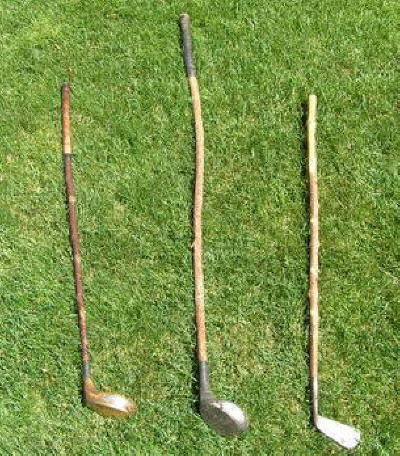
"Barkies"
--- as shafts likely were shortly after the beginning of the
game ---
My
putter, driver and fairway all purpose cleek.
|
These
are some clubs that I made many, many years ago that I still
enjoy playing with. The shafts of all three are suckers that
grew out of the ground from under a hazel nut tree that one
day I cut while I was on a Sunday walk in parkland at not
very far away Blebo Craigs, which is near St. Andrews. Hence my name
"Barkies." The
putter with the wooden head on the left and the driver in the middle I
weighted with lead that I found at the Rumbling Goat near
the Chapel at Earlsferry. The old rusty iron mashie head I
found in the long bent grass of the links by the beach at the West
Sea.
When exactly the gowf started on the Earlsferry links
is lost in the mists of time. During the 19th
century there were several established businesses in
Earlsferry that employed most of
the available men in the business of making golf clubs. The
need for men to work in the trade was so great that men from
the neighbouring villages were traveling to
Earlsferry to work in the shops
of the Earlsferry golf club
makers.
My dad
Tom Reekie was born in
the neighbouring village of St. Monans in 1880. In 1895
when he was 15 years old he
became an apprentice golf club maker in
Earlsferry. From the several
golf club making establishments
in Earlsferry to choose from he
decided to join the firm of George Forrester. He chose
George Forrester because Forrester was an inventor and an
innovator. Forrester had constructed specialized
labour saving machines for the
making of golf clubs and golf balls. Forrester had brass
molds that he used to make gutty
(gutta
percha) golf balls. Forrester invented and
constructed a machine to wind rubber elastic ribbon into
balls around which he molded a cover. Prior to George
Forrester inventing the method of attaching the golf shaft
to the wooden head by means of a tapered hole in the head and
tapering the shaft to fit, golf
club shafts had been attached to the wooden head by means of a long
tapered and glued scarf joint. The long joint was then
reinforced by wrapping the joint with pitched string.
Forrester constructed pencil sharpener
type machines to form the taper on the end of wooden
golf shafts and also special machines to taper drill the
wooden heads. George Forrester was granted his patent in
1898. Not exactly rocket science but clubs with a long scarf
joint to attach the shaft to the head had been made that way
for over a hundred years. From then on all clubs were made
Forrester's way.
In the early 1930's, in my
early days of playing golf on the
Earlsferry links, after the
gutty ball was long obsolete,
gutty balls were still being found in the rough of
the links and among the bents at the end of the West Sea
Road at West Bay, especially when westerly winds and big tides bit into the
grass banking of the shoreline.
George Forrester, my father's
employer, lived in the house called
Georgeville on
Links Road near the corner of The
Ferry Road in Earlsferry. The 19th. Hole Pub is immediately to the west of
Georgeville. A very civilized and appropriate place! George Forrester's golf club making
business was carried on in a building
just behind Georgeville. He made available the living room of
Georgeville for others to use as
a golfers club house. The starting tee of the
Earlsferry golf course was just
a few steps from his front door at The Ferry Road.
What became the
Earlsferry Golf Course is the
links area of the common lands of the
village of
Earlsferry. This is the ground that lays to the west
of the Ferry Road. This land was more or less an area of
wind blown sand on which bent grasses had taken a hold. The
land was too poor for farming and was only suitable for the
grazing of sheep that kept the grasses cropped to a low
level. I remember one year in the lambing time that the
links was still covered in deep snow and the lambs were all
born in trampled out hollows made by the mothers.
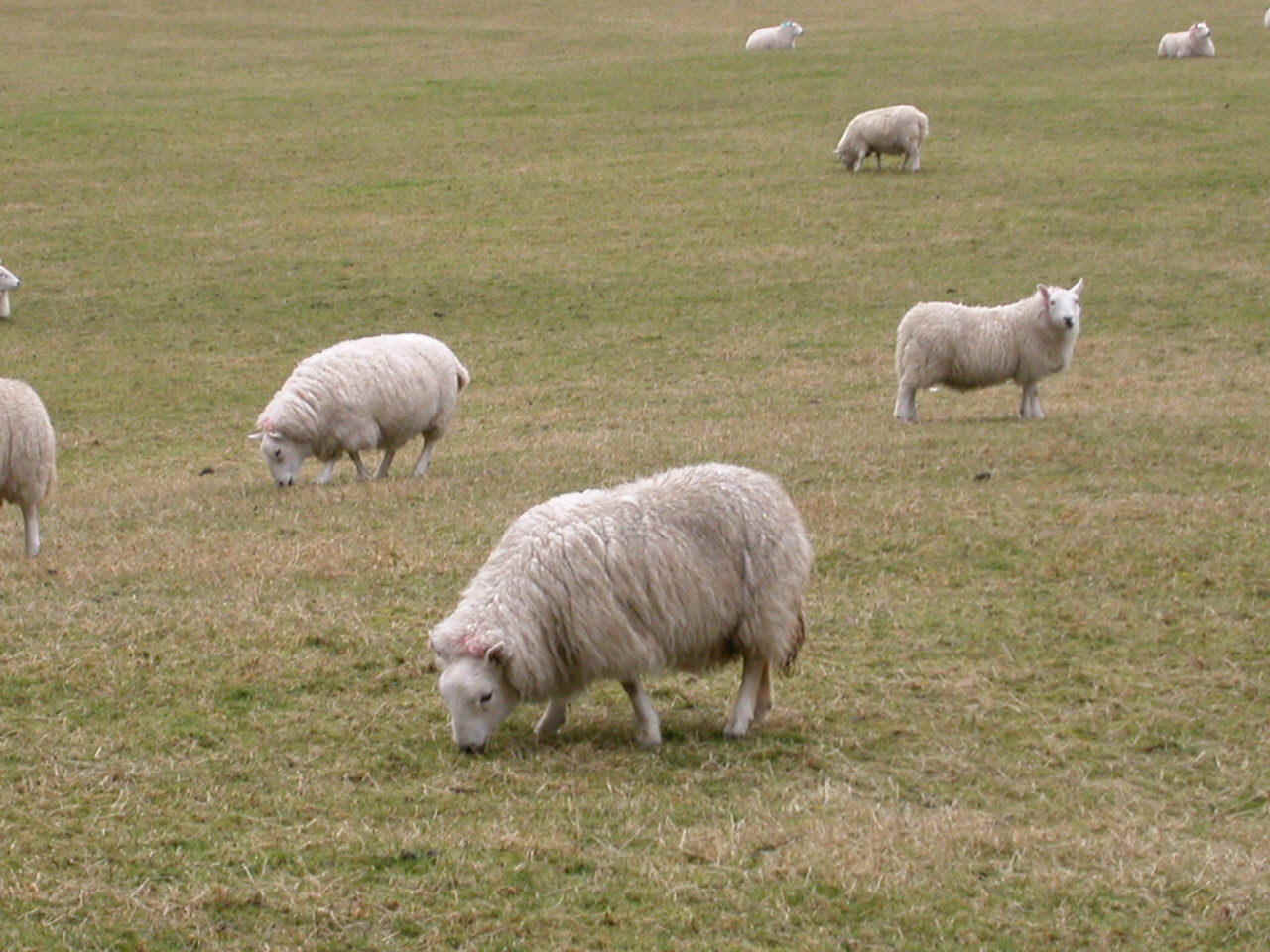
Sheep were the natural lawn mowers of
the links.
It's quite possible that a sheep herder was
the first
person to play what became known as the game of gowf. Somewhere on one fateful day
did a shepherd take his crook, turn it end for end, and for
whatever reason take a swipe at a dried out sheep dropping?
One day while playing on the
Ferry Links I hit a screamer of a drive but when my ball
came down I saw that it hit a sheep that was grazing
in the middle of the fairway. When struck, the sheep leaped
into the air then ran off to mingle with others of its kind.
When I got to where the sheep had been my ball was no where
to be found. I presumed that it must have become trapped in
the sheep's long, matted wool. Wonder what the R&A rule is
for an occurrence such as a sheep running off with your
ball?
Since where and when the birth
of the game of gowf began the world has never been the same
since. Several towns make claim as to their town being
the birthplace of the game of gowf but as far as I know, no
record exists as to who was the first person who actually
played the game. Earlsferry
while making no claim, could just
as well have been where the game started, not that it
matters. Gowf has certainly been played on the links at Earlsferry
for a very long
time.
With the land that comprised
the Earlsferry Golf Course being
the common lands of Earlsferry,
we Earlsferry people
played our friendly games of gowf as and when we pleased. This was
our prime pastime.
Later as roads were developed and cars became popular,
others from outside of the village came and desired to play
on the links. The number of people wishing to play
increased as the town of
Earlsferry
had no method in place to charge out-of-the-village people to play on the
links.
At some point in time the
administration of the Earlsferry links became entrusted to a private group.
After my father Tom completed
his apprenticeship in 1900 he continued to work for George
Forrester until he received his call-up papers to serve in
World War I that began in 1914. When he returned in 1918
he went back to working with Forrester. In 1919 my father
Tom and Katie Ferguson, who also lived at St.
Monans, were married.
Tom and Katie moved to
Earlsferry where they bought the
house, "The Cross," just across the street from the
Earlsferry Town Hall. From the back garden of The
Cross a lane lead to Forrester's
workshops, Georgeville and to
the links.
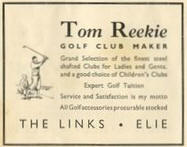
In 1919 Tom left George
Forrester and hung up his own shingle, "Tom
Reekie Golf Club Maker." Tom
bought iron heads in the rough, that were forged on his
dies, from either the iron golf head blacksmith shops of
Anderson or Brodie at
Anstruther or from George
Nicoll at
Leven. Tom also bought beech and persimmon heads in
the rough and hickory and greenheart golf shaft blanks mainly from the firm
of Gibson at Kinghorn. In
addition to making clubs Tom sold the accessories connected
with the game. Tom loved to teach others how to play. Later the teaching side of the business took all of
his time during the summer months. Tom's star pupil who went
on to become a champion play golfer was a lady by the name of
Mrs Holmes.
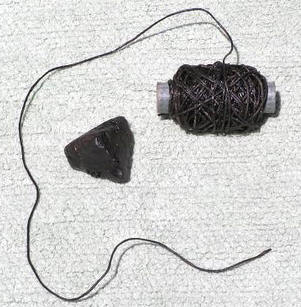
Waupin, some
that I made about 1935
When I was a young boy a job
that my dad assigned me was the making of waupin. (whipping) Pitch coated twine. This
material was used to secure the leather grip to the shaft and
also to strengthen and cover the transition of where the
wooden hickory shaft joined the
wooden head. This job I did by drawing fine string through
an entry and exit hole in a can of molten pitch. I set up
this job on the Links Roadway just as my dad had done when
he worked for George Forrester. As I pulled the string
through the melted pitch I stretched it out along the
Links Road to give it time
to harden and become tacky dry before I wound it on to small spools.
Another job I did was paint golf balls. As a teenager in the
summertime I helped out by selling anything and everything
that was for sale in Tom's golf shop.
All wooden headed golf clubs were
weighted with lead. To fill the chiseled-out cavity
in the head with molten lead an oval shaped clay dam
had first to be formed on the head to keep the lead from
overflowing as it was being poured into the cavity. Before
the lead was poured in to the cavity, to keep the lead from
ever becoming loose, three holes were drilled down into the
base of the cavity at oblique angles and threaded such that when the
molten lead hardened it was locked in place. It was my job to keep the clay bucket filled with clay by going to
Ruddons Point to get it. Just below the high tide line
at Ruddons Point at the east end of Largo Bay and right
where the Cockle Mill burn meets the sea is a bed of the
very best pure clay.
The
preferred finish of the wooden heads was three coats of rosewood
stain then four coats of shellac varnish. Between
each coating, except, the last, the head was lightly sanded by hand.
Another of my jobs was to keep the varnish jars full and to always
have on
hand a new supply of applicators for the stain. The varnish I made
by mixing dry shellac flakes with purple dyed mentholated spirit
until it got to the right consistency. The
stain applicators I made by wrapping a strip of cloth from an old
flannel shirt around a flat stick. All of the ingredients to make
the stain, which was primarily dissolved potassium permanganate
crystals, and the ingredients to make the shellac varnish were bought from Gray and Pringles
ironmongery shop in Anstruther.
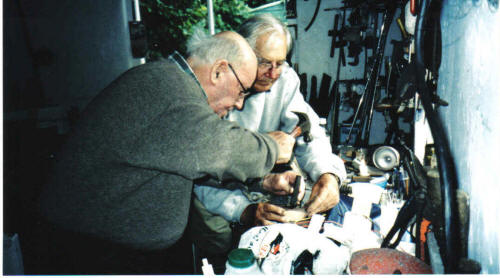
John hand stamping the
name, Tom
Reekie.
His assistant is me.

My brother, John, in
his workshop.
To make the wooden
heads, the wood of choice of both
my dad Tom and my brother, John, was
Arkansas persimmon.
The trickiest part of the whole
job of making a wooden golf club, that at the very last
minute could ruin the club, was the stamping on the head of
the signature name,
Tom Reekie.
The name was stamped in black. First the steel, hand held,
signature stamp was held low
down in the flame of a smoking candle until the name, Tom
Reekie on the stamp was
thoroughly coated with carbon black soot. The stamp was flat and the wooden head was curved.
Contact with the stamp and the head had to be made at the
end of the name. This took a very good eye and steady hand
pressure. When alignment was thought to be perfect a light
hammer blow was struck on the stamp. Then very carefully the
stamp had to be rocked to follow the curvature of the head
as between each movement the stamp was lightly struck with
the hammer until
the entire name was completely embossed. If the club moved only the slightest
amount during the stamping and the name got slightly off
angle or not centered properly or not marked evenly the club
would not be sold. Our garden was well supplied
with hickory plant stakes!!!!!!
In addition to my dad Tom
Reekie and my brother John Reekie, others who were in the
business of making golf clubs in Earlsferry during
the 20th century that I remember include the names
Mc.Duff, A.H. Scott,
David Scott, Crowley,
George Forrester, Jim
Forrester, Jack Forrester, James Donaldson, Jack Ballantyne
and no doubt others that I've forgotten. The business of
A.H. Scott had been designated Golf Club Maker to the Royal
Family and the trade mark stamped on Scott's clubs was a
royal crown. Scott's golf club making business in
Earlsferry grew to the extent
that he used a stationary, horizontal steam engine to drive
overhead line shafting to power
his many individual golf club making machines.
Among my collection of
Earlsferry made old wooden shafted golf clubs are a Scott niblick
and a Gem putter both stamped with the Crown, a Jim Forrester
mid-iron, a Jack Forrester mashie, a Mc Duff driving iron and of course several old
Tom Reekie clubs and the ones
that I made from scratch by myself. One of my "barkie"
clubs that I prize greatly is one that I made from an
old brass (most likely bronze) Tom Morris,
St. Andrews, putter head, which, when I was a boy, I shafted
with a somewhat crooked sucker from a hazelnut
tree that was growing at Blebo Craigs, just a few miles from
St. Andrews. Despite having a crooked shaft it has good
"feel" and is a very fine putter. It does have one problem
though and that is that just about every golfer who handles
it asks, "Want to sell it?"
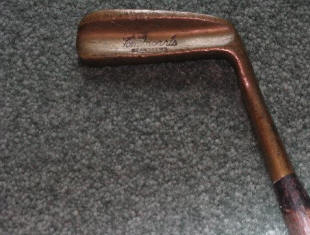
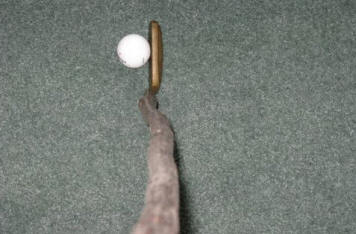
To begin with my dad, Tom
Reekie, made and repaired golf
clubs, mostly for the local players of the game. However
while Tom was good at making and fixing clubs and teaching
others how to play the game Tom always went on about as to
what was the real reason for playing golf which was spending
time with friends or family. Always, on the course, you would
hear words of praise and admiration for a well played shot
and words of commiseration when someone's ball was buried
deep in the rough or lost or a putt that there was no way
could be missed, was.
December
26 2008.
I recently
received an email from Jiri Martinka of the Czech Republic.
His purpose for writing was to tell me that a juvenile size, old hickory shafted
brassie, with the name Tom Reekie stamped on it, had recently come into his possession. By
this web site Jiri found me. If this wee club could talk what a story it could tell. In the course of its
roughly 80 years of existence how many have used it?
Born in
Earlsferry, how has it survived for all these years and now is in Prague?
But
this lovingly hand made golf club's travels aren't over yet. The purpose of Jeri's email
was
to tell me that although he is a collector of old clubs he thinks so much of this little club and it being
so far from Earlsferry that he generously offers to send it
"back home" for safe keeping to one of the progeny of it's
maker. Now that's "feeling" for the game and others.
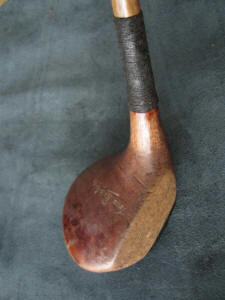
Jiri
is an ardent player of the game as it was played in the days
of the old hickory shafts. I bet Jiri, just like me, has a lot more fun
playing the game with old clubs that were made in the days of yore than someone
who is equipped with a huge bag full of the latest graphite and
titanium offerings, electric golf cart, etc. etc. etc.)
February 5th. 2012
Today
I received an email from Mike McClenan . Mike who lives in
Warrington, Cheshire in England wrote to tell me that he has an old
Tom Reekie Gem Putter and that he wishes to return it to me or to
one of the Reekie family. What a beautiful gesture . You can be sure
that in the days to come when Mike's gem putter is hanging on a
Reekie wall that its story will be told. There certainly is a lot of
sentiment and feeling for old golf clubs and their makers and the
players who have used them for many, many enjoyable years. I'm sure
my dad, Tom, would be flattered as to how he is thought of and
remembered. Just think.
Tom's old clubs will be hanging on Reekie walls and no doubt the
walls of others for most likely
hundreds of years.
Before the advent of the motor
car, roads were relatively unimproved. Visitors who wanted
to play on the Earlsferry Links
who came from anywhere other than a few miles away were few
and far between.
In my early days of playing on
the Ferry links, Earlsferry people played the game as a 14 hole
course. From the 1st tee the fairway
went west from The Ferry Road and the 14th hole
ended back at the
Ferry Road. Sometimes after playing the 14 we
kept on playing and went around twice. All of the Earlsferry
golf course was to the west of the
Ferry Road.
The West Sea Road is fortunate
that it did not suffer the same fate as the Cadgers Road by
being filled in and no longer visible. The
West Sea Road
paralleled the now 6th hole of the golf course. This road was well
traveled by the public for vehicles to get from
Earlsferry to the West Sea beach
where there was a parking area at both ends of the road.
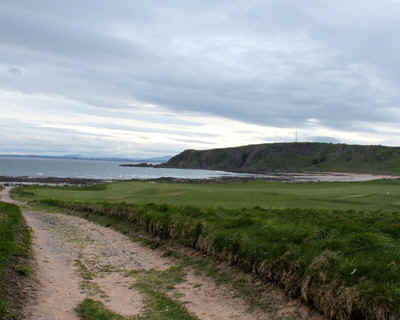
Treasure trove.
The road from
Earlsferry to the West Sea.
How many hundreds of
years, no, maybe thousands of years, has it taken to
create this well worn, sunken, rutted roadway? It could well be
that long before the advent of the gowf this track to the West Sea was travelled by,
ponies,horses and the people-of-old who made the,
under-the-ground, Elie, Ardross Souterrain, two miles to the
east.
Straight out from the sea end of the West Sea Road was a commercial
salmon fishing operation. Each day, when the tide was fully
ebbed, vehicles traveled the roadway when the fishermen serviced the nets
and removed the many huge
salmon that were caught. The Earlsferry
villagers used the road extensively to transport
driftwood and sea coal that had been garnered from the West
Sea beach. The roadway was also used to transport used
building stone etc. to rip-rap the shoreline where the sea
continuously caused erosion.
After World War II, Jems'
brother, Sandy Linton, operated a wood
storage and firewood cutting and bagging business near the
sea end of the
West Sea road. To power his wood
cutting saw, Sandy jacked up one rear wheel of his lorry
then attached a flat belt from the wheel to the saw before
starting up the engine of the lorry and putting it in gear
to get the saw blade spinning. Quite ingenious but
highly dangerous.
The rocky area
between the high and low tides from Chapel Green and
the West Sea Road produced a prolific amount of wulks
(whelks/periwinkles)
which materially contributed to the economy of Earlsferry
people who made a business of gathering them. This was hard but
healthy work. Those who were gatherers with all
the fresh salt sea air were a ruddy complexioned happy group.
As the wulks were gathered by hand they were loaded into
twenty pound gunny sacks which were then taken by the West Sea road
to the railway station at Elie. From Elie the local train took
them to Edinburgh and the overnight train from Edinburgh
took them to the Billingsgate, London wholesale fish market where
they arrived the next morning to be sold at auction. As an
item of interest read my "Earlsferry Lobster" page about what can be done at the 11th., the Sea Hole.
The 6th fairway paralleled the much traveled West Sea Road and the
10th and the 12th fairways were at right angles to the
roadway. This was a unique situation and both golfers and roadway
users observed and gave way to the other as and when there was a
need but vehicular travel came to a halt when one day, about 1950 or thereabouts,
without warning, men came and blocked the ancient
public roadway from Earlsferry to the West Sea.
Most everybody, young and old,
in Earlsferry played golf. In
these days golf was a very informal game as the game was
completely unregulated. If there was a line up at the first
tee to start play, players just walked out to start their
game from any hole they pleased and finished the same way.
Usually five clubs were all we carried, but sometimes seven.
In my early days of playing on
the links the fairways were much
narrower than they are today and weren't mowed like the
present. The greens, while the grass was kept relatively
short, were tiny by today's standards. Putting to the hole
was mostly done with a lofted putting
cleek and of course we always putted and attempted to
create a stymie. Wooden tees hadn't yet come on the scene and at each
designated driving-off tee site was a small wooden box
filled with sand for the player to take a pinch to tee up
the ball.
|

My
first club
|
In 1931 when I was five years
old my dad made me my first golf club and I started to play
the game. It was Tom's habit to make for each child in the
village his first tiny club. By the time my brother John
was eight years old he was already a good golfer.
|
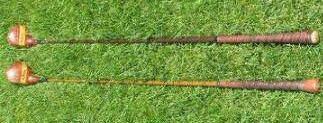
|
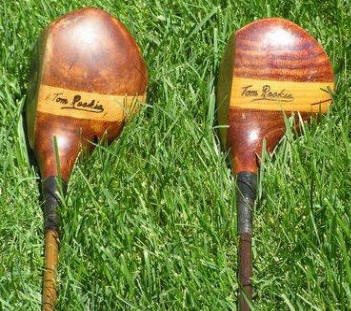
Above
on the left my lifetime favourite driver.
|
|
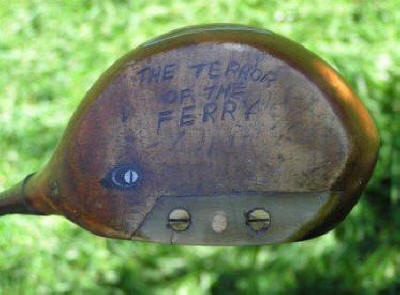
Someone
marked this on my driver |
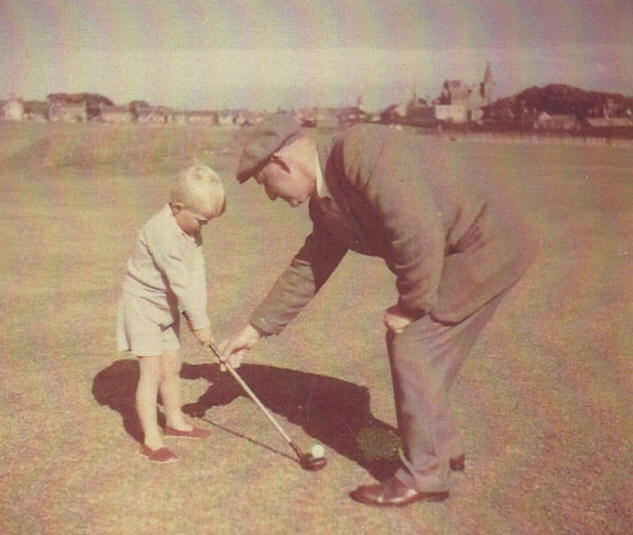
The old and the new.
Tom loved to teach
children.
The wee white haired
boy is Graham Johnston.
In all the years that John and I played together I
don't think I ever beat John. John had a beautiful and
relatively slow but perfectly timed swing. At the end
of his swing John held that position for at least five
seconds before lowering his club as he watched his ball in
flight. John's ball
always went dead straight down the middle of the fairway.
On
the other hand I was a long hitter and lashed out at the ball like
a Tiger Woods to the extent that my driver acquired the well
deserved name, "The Terror of
The
Ferry."
As soon as I hit my first drive, which might end up many
yards beyond John's drive, John would just smile and say,
"Well, we know who'll be the winner of this game."
How right he was!
John's
advice to the golfer
|
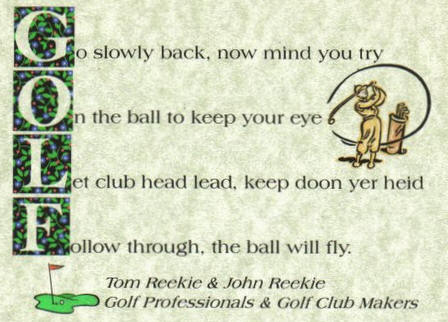
|
|
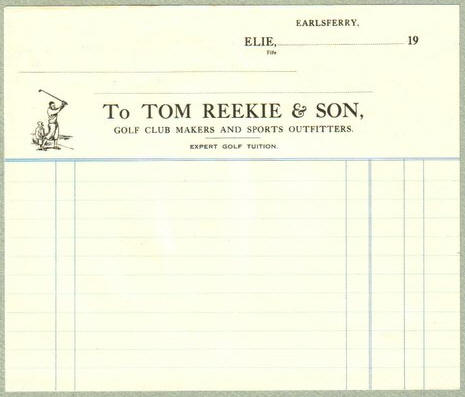
|
After World War II ended in
1945 John joined our dad Tom Reekie
in his golf business and the name changed to "Tom
Reekie and Son, Golf Club
Makers." Their activity all winter long was to hand make
sets of golf clubs all of which were sold by the end of the
next summer. All summer long they both tutored others how to
play the game, sold clubs and golf accessories and did club
repairs. Jenny, John's wife, also played an active part in
the business especially during the busy months of the
summer. After Tom retired John and Jenny carried on the
business by themselves until John finally retired. After
John and Jenny closed their business it was a good number of
years before their old friends and customers finally stopped
knocking on the door of their house with request such as,
"John, I have a favourite club that needs fixing. Could you do it
for me?" John never refused. On being asked, "How much
do I owe you?" John, with a twinkle in his eye, would
invariably smile and say, "That's all right ------glad to do
it for you."
|
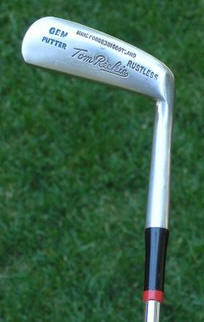
It
is a Gem and a gem of a putter. |
I have many fond memories of
my dad Tom Reekie and golf in
Earlsferry but this is a
happening that's given me many a chuckle. One day I was standing
on the Ferry Road with my
dad Tom Reekie.
We were watching
visiting golfers teeing off at the fourth. One of the players sclaffed a
miserable drive that skittered a short distance along the
fairway about to the old well that is only about half way to
the Cadgers Road. As the player,
with a disgusted look, returned his driver to his bag Tom, who'd been scrutinizing
the player and his club, made the remark, "Man, that's an
awfy looking
bauchle (an old worn out down at the
heel shoe) ye're playing
wi'." At this the gentleman retrieved
the club from his bag and handed it to my dad for his
inspection. Great was
Tom's astonishment and embarrassment as on looking the old
club over the name stamped on the club's head was Tom
Reekie. For a moment there was
silence then, not to be outdone, with an innocent,
nostalgic, reminiscent, faraway look, a pawky smile and a twinkle in his
eyes, Tom saved the moment as he looked up, shook his head, and
sighed,
"Aye,---- but it's been
a braw club in it's day."
After
about a hundred years the
business
of Tom Reekie and Son is now a part of
Earlsferry golfing history.
|
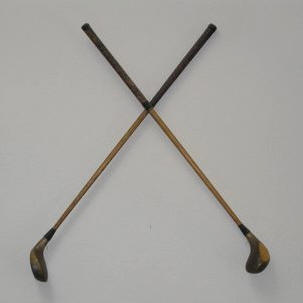
Now, memories on my wall. 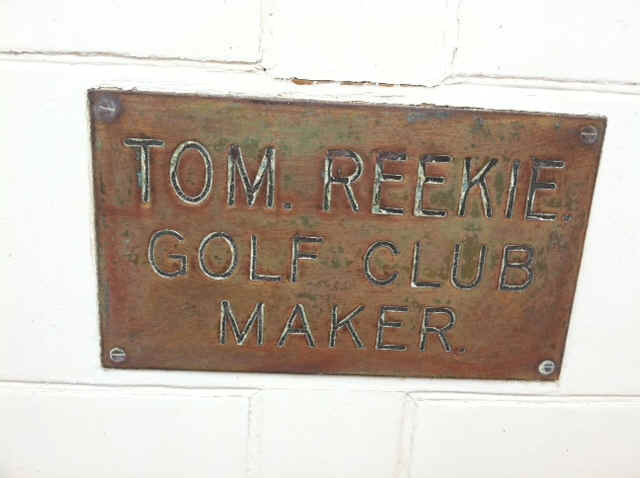 |
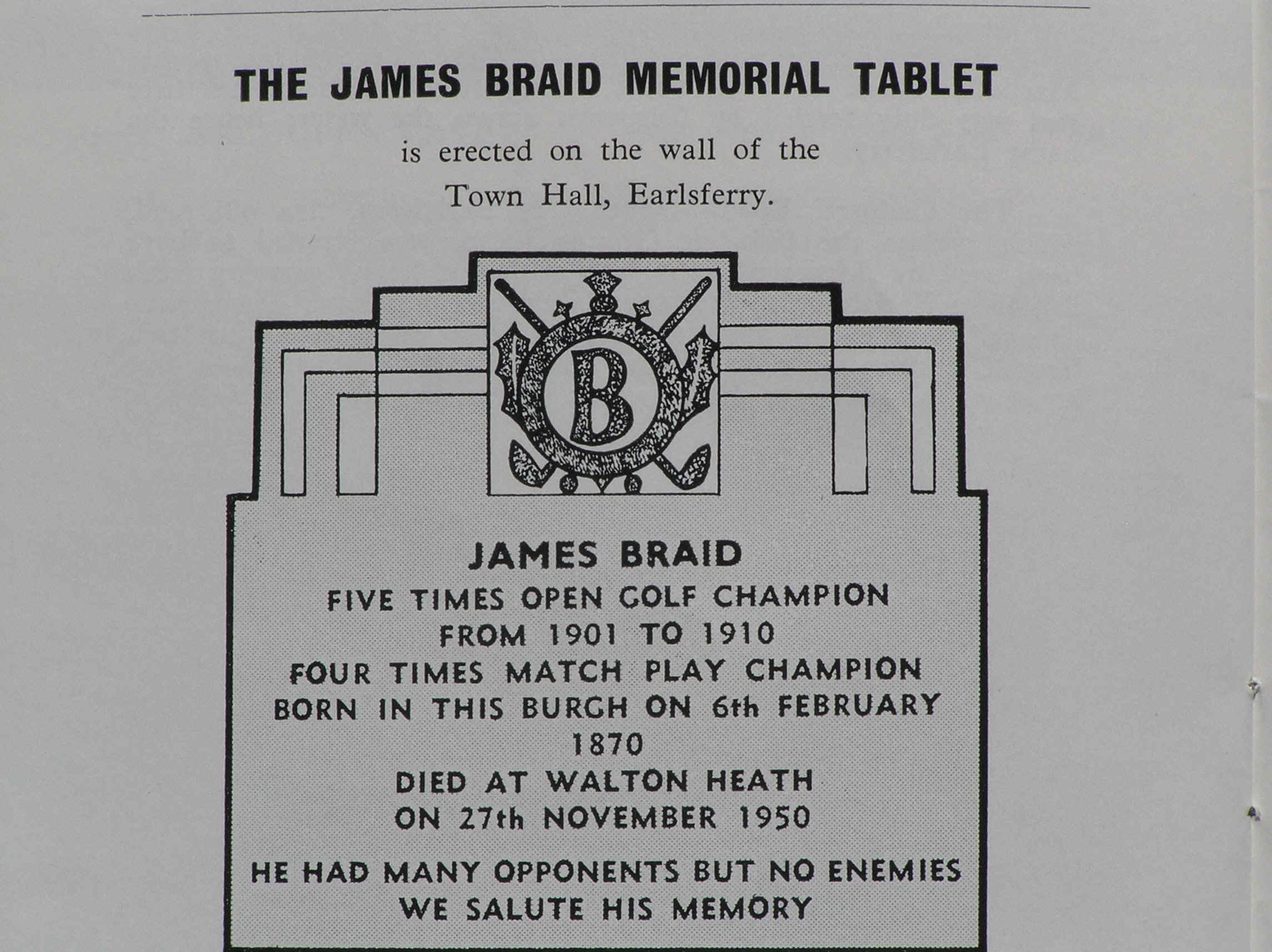
Earlsferry produced a
considerable number of excellent golfers, the most notable
being James Braid who, with Harry Vardon and John Henry
Taylor, was one of the
famous trio that comprised the
British Golf Championship Triumverate.
My father, Tom, and brother,
John, taught many players the game of golf, some of whom
also become world famous. You can read more about it on the
History
page of the Elie Sports Club.
